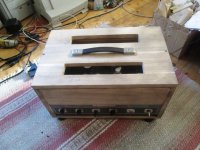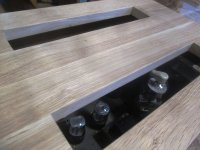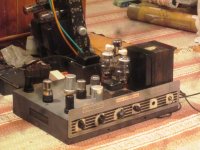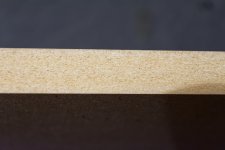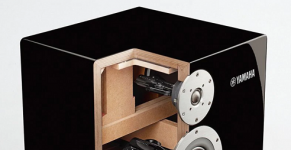Sustain just means not enough damping surely?
I read it as meaning getting a high Q resonance excited, once excited, it will ring for some time — like a bell. But if you can get the potential resonance high enuff in FR, with high enuff Q, you will never get sufficient energy from the music to excite it. HFs have less energy, and since most has to travel thru the cabine structure, all the damping at each ply transition, the HFs get damped ot fairly quickly.
Tap it with a hammer you might get it to ring, but not likely to ever get the sustained, exact frequency needed to “charge” any HF, Hi-Q potential resonance.
dave
MDF is good sound wise
Plywood is almost the same.
I know somebody who made the two version of the same cabinet : they sounded the same.
The advantage of plywood, is the mecanical resistance , way better than the one of the MDF
The advantage of MDF, is for the perfection of finitions : perfect for chanfering , and ready to be painted.
Making a sandwich of Plywood and MDF is a fine solution, but nothing replace a good bracing.
Plywood is almost the same.
I know somebody who made the two version of the same cabinet : they sounded the same.
The advantage of plywood, is the mecanical resistance , way better than the one of the MDF
The advantage of MDF, is for the perfection of finitions : perfect for chanfering , and ready to be painted.
Making a sandwich of Plywood and MDF is a fine solution, but nothing replace a good bracing.
Well honestly I think it is more important to make speakers than endless debate bout what is the best material to make cabinets with. However one of the deadest subwoofer boxes I ever made was using a couple of scrap shipping boxes made from thin 12mm chipboard that I glued scrap MDF panels to on the inside and whacked in some stiffening at random.
Glue; lots and lots of yellow PVA glue.
Only reason it isn't still in the lounge room is that SWMBO objected to a big black refrigerator in the corner, It's now part of my party system
Glue; lots and lots of yellow PVA glue.
Only reason it isn't still in the lounge room is that SWMBO objected to a big black refrigerator in the corner, It's now part of my party system
The difference between OSB and high-density chipboard is described and illustrated within this link:
https://www.trend-uk.com/en/UK/trend/content/content_detail.php?record_type=Knowledge&id=20910
Thanks to Scotland for that interesting link to materials.
Excellent.
My use of materials was just a big learning curve, thanks to good timely advice
I made a vintage amp an oak case.
Looks beautiful now, again the same workshop did the donkey work for me.
(ex-soviet union countries,- brilliant working in local materials)
No way would that have been done in pine or chip, - way too weak.
In this case it has to resist heat, and of course keep fingers away from those 600V top caps. (make them impossible to access in use), at the same time as funnelling all that heat out of there...
+
Also made to measure came out 1/4 the price of any commercially made stuff off the www.
Attachments
Last edited:
Glad you found it useful. When it comes to agreeing on which material we are talking about, a picture is worth a thousand words!Thanks to Scotland for that interesting link to materials.
That's a really solid amplifier case you have pictured. Your use of OAK is way better than OK!
Yes, I am thinking of doing that again to house the monster heavy MO200 (2 x 100W) amp.
(I have a pair).
Believe it or not it cost me just 40E including the wood and cuts.
I discovered that bunch of hard working craftsmen entirely by accident one day, on the industrial estate, close by.
Their work inc material for the ginormous speakers cost only 240E, and they even gave me the glue. They cut it all up ready for me in an hour dead!
Gives a whole new meaning to the 'design and build your own speakers!"
I used ROCKWOOL for the internal damping.
That was cheap on special offer too.
(I have a pair).
Believe it or not it cost me just 40E including the wood and cuts.
I discovered that bunch of hard working craftsmen entirely by accident one day, on the industrial estate, close by.
Their work inc material for the ginormous speakers cost only 240E, and they even gave me the glue. They cut it all up ready for me in an hour dead!
Gives a whole new meaning to the 'design and build your own speakers!"
I used ROCKWOOL for the internal damping.
That was cheap on special offer too.
Tile/green glue damping, dissimilar materials for the exterior and bracing, both would appear to be effective. It's just missing poly or some sort of fill.Interesting design.
And, contradictorily, this will not produce a leaden sound!I put some laminations of lead where needed and secured them with glue and screws
How about the exact opposite? I've been trying to find a YT video I saw a while back (to no avail) of a thin, sound deadening material used in construction. An open ended frame was covered in it and placed over a generator, very impressive noise reduction. It was a rubbery viscous sheet, I imagine it would also have had a good damping effect on the internal sound. Just a thought and OT, but, what the hell, hasn't this question been discussed ad nauseam? 
...and having essentially no energy in whatever resonance that is and a healthy loss factor in the acoustic impedance mismatch and glue interfaces. Maybe not the best use of weight, but I definitely don't see it as being *worse* if one's plan is to make a dead cabinet. (in reply to Dave, not SJ)
One could make a very lossy brace by having two walls connected by two shelves (bonded to only one wall, respectively), with a lossy shear layer.
e.g.
|xxxxxxxxxx | upper brace (left side bonded)
| SSSSSSS | shear layer
| xxxxxxxxxx| lower brace (right side bonded)
I believe Earl Geddes said something to the effect that this was an extremely effective dampener as the displacement in the shear layer is maximized.
e.g.
|xxxxxxxxxx | upper brace (left side bonded)
| SSSSSSS | shear layer
| xxxxxxxxxx| lower brace (right side bonded)
I believe Earl Geddes said something to the effect that this was an extremely effective dampener as the displacement in the shear layer is maximized.
Member
Joined 2009
Paid Member
And, contradictorily, this will not produce a leaden sound!
it’s probably good for heavy metal
I put some laminations of lead where needed and secured them with glue and screws
And, contradictorily, this will not produce a leaden sound!
Lead guitarit’s probably good for heavy metal
Wait! I'm talking about my speakers™

Still WIP
Little by little
It's a LVR, not BVR
- Status
- This old topic is closed. If you want to reopen this topic, contact a moderator using the "Report Post" button.
- Home
- Loudspeakers
- Multi-Way
- Is MDF or plywood better for speaker cabinets?
